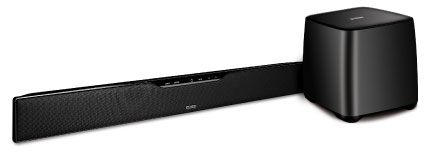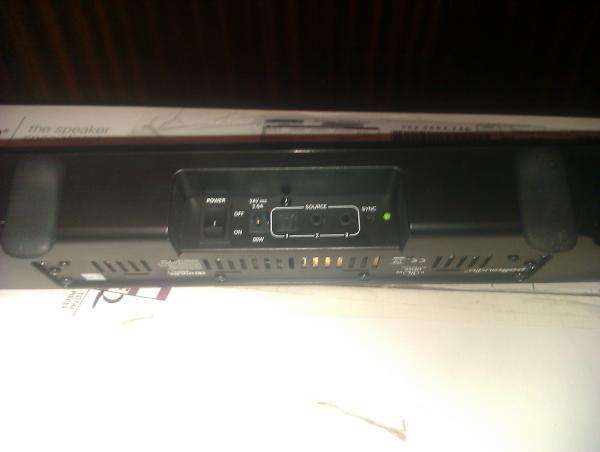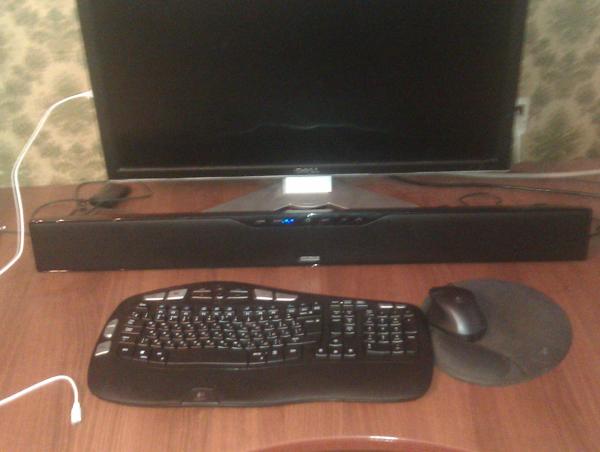Three-dimensional sound from one speaker. Polk Audio SurroundBAR 6000 IHT soundbar overview

Audio systems 5.1 and 7.1 have long become familiar and do not cause any emotions. It would seem that it is impossible to come up with anything new in the field of three-dimensional sound - except perhaps the multichannel headphones that have recently been bred.
Nevertheless, progress still does not stop. One of the latest trends in the development of audio technology is sound panels with three-dimensional sound. Imagine - no piles of speakers, one single panel in front of you, and the sound - from behind, on the sides, in general - like in a movie theater.
')
This category of products in Russia among audiophiles has gained not the best reputation because of the rather failing models of several firms. Including on Habré cursed on the soundbar from Philips. However, I did not give up hope that maybe, after all, one of the developers would have something efficient to do.
I happened to touch one of the latest developments in this area - the Polk Audio SurroundBAR 6000 IHT panel from the first batch delivered to Russia. This panel not only belongs to this very interesting category of gadgets, but is itself a major breakthrough in this area.
The reasons for the failure of predecessors, the experience of use, technology, work and differences from traditional systems and other panels - in this review.
I apologize in advance for the quality of the photos in the article - filmed on the phone.
The necessary preliminary explanations for those who have never heard of sound panels, or "Are you kidding me?"
Yes, the sound is three-dimensional. From the rear, on the sides, even vertically.
No, this is not Herbalife - sound panels are represented on the market by many well-known companies - Yamaha, Sony and so on. However, their panels are focused on use in home theaters and are technologically the last generation. Not too successful though. Why - below.
The difference between the panel of the company Polk Audio (by the way, a very well-known manufacturer of audio equipment, mainly automotive, in the States), which will be discussed in a very "tasty" technology. Well, and in very rarely targeting soundbar manufacturers, including on PC users.
However, the role of acoustic systems for home cinema SurroundBAR 6000 copes no worse, if not better than competitors. Why - read below.
Good. And how does it work?
I'll tell you briefly, since the purpose of this review is to review a specific new product, not a technology. If the users are interested, I can later write a separate article about the technologies of the various panels.
So, we hear with two ears. The location of the sound source calculates the brain using two parameters for analysis - the difference in the volume of sound perception by different ears and the distortion introduced into the sound by the shape of the auricle.
Differences in volume give the brain data on the location of the sound source along the axis "left-right". The distortions introduced by the auricle make it possible to determine whether the signal source is higher or lower from behind or in front.
Accordingly, in order to get rid of the "extra" speakers in a multichannel system, it is enough to create a sound that satisfies these two conditions.
But everything is not so bright - they have been struggling with this task for decades with varying success. As it turned out, our ears are much more difficult to deceive than ourselves.
Algorithms for introducing positional distortion in sound have long been known - for example, Cetera Algorithm, which is used for impressive recordings for headphones, for example, the Virtual Barber Shop . To translate HRTF processing in real time and create truly realistic distortions is the first problem.
The second one - no matter how many sources of sound there are - if they are not headphones, then the opposite ear can hear the sound too loud - and the brain guesses that the sound goes through the speaker.
This is called internal auditory crosstalk - IAC.
Increasing the number of columns does not help much in overcoming IAC - the ear still guesses the arrangement of multiple speakers easily and naturally.
The use of HRTF algorithms are those “crutches” that make multi-column systems create realistic sound, albeit on a tiny patch of “sweet-spot” 'and after a long adjustment and with a very serious dependence on the shape of the room, its acoustic properties and the location of objects in it.
Most sound panels work in a manner similar to multi-column systems — using sound reflections from walls, floor and ceiling to create additional virtual speakers.
The result, unfortunately, is not too impressive - a fake multicolumn system is unlikely to sound better than the real one. Moreover, you can safely forget about open windows, use in small rooms or rooms of complex shape.
As well as about the use of the computer - too close to fit the panel "out of focus" reflected sound streams.
For this reason, by the way, the belief has spread that all sound panels provide three-dimensional sound only on paper.
Polk Audio engineers managed to solve all of the above problems. By the way, they managed quite a long time ago, several years ago, using this solution for home theater audio systems, but only recently they released a relatively compact model, positioned as intended not only for televisions, but also for computers.
The basis is a technology called SDA.
To solve the IAC problem, additional speakers are placed on the panel, transmitting the inverted sound of the opposite side, thereby muffling a too loud sound for an “unnecessary” ear. It looks like this:

The guys from Polk Audio were able to identify common features in the spatial distortions introduced by the auricle, characteristic of all people. The built-in sound processor of the panel adds these distortions "on the fly", providing the illusion of sound from all sides.
Pure illusion (after all, the sound actually comes from the front) - but very convincing.
As a result, it is possible to use in rooms of any shape, three-dimensional sound at any distance from the panel and at a large angle to it, no distortion in sound, if someone came into the room, no sound problems with open windows, and so on.
In short - the Polk SDA technology has transferred sound panels from a wonderland area for geeks to a completely usable, albeit expensive and state-of-the-art technology.
So what does this look like in practice?
Unpacking
We turn to the review itself.

Inside the box, we find the panel itself, a wireless subwoofer, a power supply, a set of wires to connect to the outlet and sound sources, and a remote control

By the way, if you plan to use the panel with a TV, it is possible to train the panel to receive signals from the usual distance unit.
Everything is packed securely, in addition to plastic bags, fabric covers are used to minimize the chance of damage to equipment during transport.

On the bottom panel of the panel;)) there is a power button and inputs - one for power and three for sound. Up to three devices can be connected at the same time - two through standard mini-jacks and one through an optical input.
A characteristic feature - you should connect a pure stereo sound, not processed in any way - the built-in processor of the panel will disassemble the sound into the channels, improve the sound and “do it well”.
This, by the way, pleases the natural miser in me - despite the cost of the panel, it’s not worth spending too much on a cool sound card to the computer too =)

Sub, bottom view.
The subwoofer sends sound to the floor - so it can be installed anywhere in the room without losing sound quality.

Next to the 30 inch monitor. A bit long, however.
The size of the panel is quite satisfactory - the height normally fits under the monitor in contrast to the panels with built-in disc players, the width is small, it can be mounted on the wall. A bit too long, but it gets up on the table normally.
Click the switches on the panel and the subwoofer. Ta-dam! All is ready. No drivers needed. Setting up the sound comes down to expanding the panel to the listener. After the circus with the setting of multicolumn systems - just a holiday =)
However, in my case, the factory setting of the wireless connection of the subwoofer and the panel during the transportation was lost, I had to find in the instructions the description of the shamanic dance to establish it. However, it took on the strength of five minutes.
How does that sound
So, the sound. The most pleasant and important part.
The sound is good.
First, the overall quality is up to par. Unlike many manufacturers of sound panels, Polk Audio did not dwell solely on the three-dimensional aspect of sound. The sound is rich, powerful, the strings sound especially good. The overall level is at the level of a good audio system. Although not outstanding, but good.
When listening to conventional stereo music that does not have a three-dimensional component, a complete illusion of powerful 1.5-meter speakers at a distance of several meters from each other is created - the so-called technology of “extended virtual scene”.
One minus, which is rather a plus - all the disadvantages of a low bitrate become audible.
The second and most important is three-dimensional sound. He is definitely better than what many home theaters offer. Of course, everything very much depends on the quality of the material being listened to, but the illusion of sound around is sometimes literally shocking, especially in computer games — I didn’t soon stop shuddering when in Snorkel Pripyat I jumped some snork — there was a complete impression that this creature jumping in my room, in the closet =)
In the movies, the situation is no worse, especially in high-budget blockbusters such as the new Star Wars trilogy. Support for Dolby Digital technology is still a significant plus.
Very pleased with the multiple sound sources and trajectories of movement of sound sources. The sound really comes at the same time from different sides, and when moving sound sources - “not a single break”, the sound field around is continuous.
The positioning of the sound sources is very accurate. As I heard, this is one of the exclusive features of this particular model. In games, this allows, for example, to shoot by ear.
It is worth mentioning the signature SurroundBAR chip with voices. On other audio systems in movies or games, voices are often muffled by third-party sounds, such as explosions. With the SurroundBAR 6000 IHT this does not happen - the voices are processed in such a way that they are always clearly audible. A trifle, it would seem - but the effect! Even in music. For example, I finally made out what the songs of Blind Guardian sang about and slightly ofigel =))))
However, there are downsides. Not all materials sound the same volume. For example, in GTAIV - although the sound comes from behind, but somehow ... artificially or something. There is no illusion. Maybe the taste, of course ... However, the point here seems to be in the specific audio material. One thing is good - the vast majority of films and games do not have such problems.
Another disadvantage - the panel works for most people, but not all. As I understand it, with a non-standard form of the ears, the usual sound distortions are different than those introduced by the panel - and the effect is significantly weakened. However, of all those who listened to my panel, such an unlucky person with a fatal lop-eared was only one. Therefore, before buying it is better to listen to the panel live, if you are not sure about the shape of your ears =)
In short, in my opinion, the panel is a very good choice for games and movies. For music, too, although for her I would still prefer classic wood columns.
In the end, we have a very good speaker system for a computer used as a multimedia center, or for a home theater in a small room (as is the case when you simply do not want to get involved in installing a large number of speakers).
Well, the wow effect can not be mentioned. Still, the concept of "front speaker - the sound behind" is very impressive.
Summarizing
+ Excellent sound, compactness, lack of piles of speakers and hanks of wires on the floor, a large space of optimal sound, no need for tuning, Dolby Digital, the overall impression of the concept.
- I would like the panel to be even smaller. The Russian price of 28000 r, although not unusual even for classic multicolumn audio systems of this class, is still scaring. Does not work at all.
In general, do not say that “must buy” in any case - but the toy is worth the money.
If you like a good sound, you have long dreamed of a home theater, but for some reason (for example, because of the size of the apartment) you could not deliver it - I would definitely recommend it.
Again, for a lover of computer toys like me, the panel fits perfectly.
Speaking of technology in general - well ... It seems that there will be no multi-column home theaters in the future - the panel is able to compete on equal terms with classical systems of the same price category. For the convenience of operation, it is definitely ahead. It seems that the soundbar finally "shot."
UPD In the comments there was a dispute about the reality of creating multi-channel audio from stereo. Without thinking, I contacted the company INFORKOM, which bought the panel. There, they answered me about the principles somehow very vaguely =), but stated that they are ready, in order to show that it still works, to receive at my office (that in Moscow) a delegation of habrovchan with me at the head to demonstrate the product. Writing to the test - in my personal. Leave wishes what exactly we will demand from them for listening. The exact date I have to report after the holidays.
Source: https://habr.com/ru/post/110292/
All Articles